At Glowskinhub.com, we believe beauty isn’t just a look—it’s a feeling
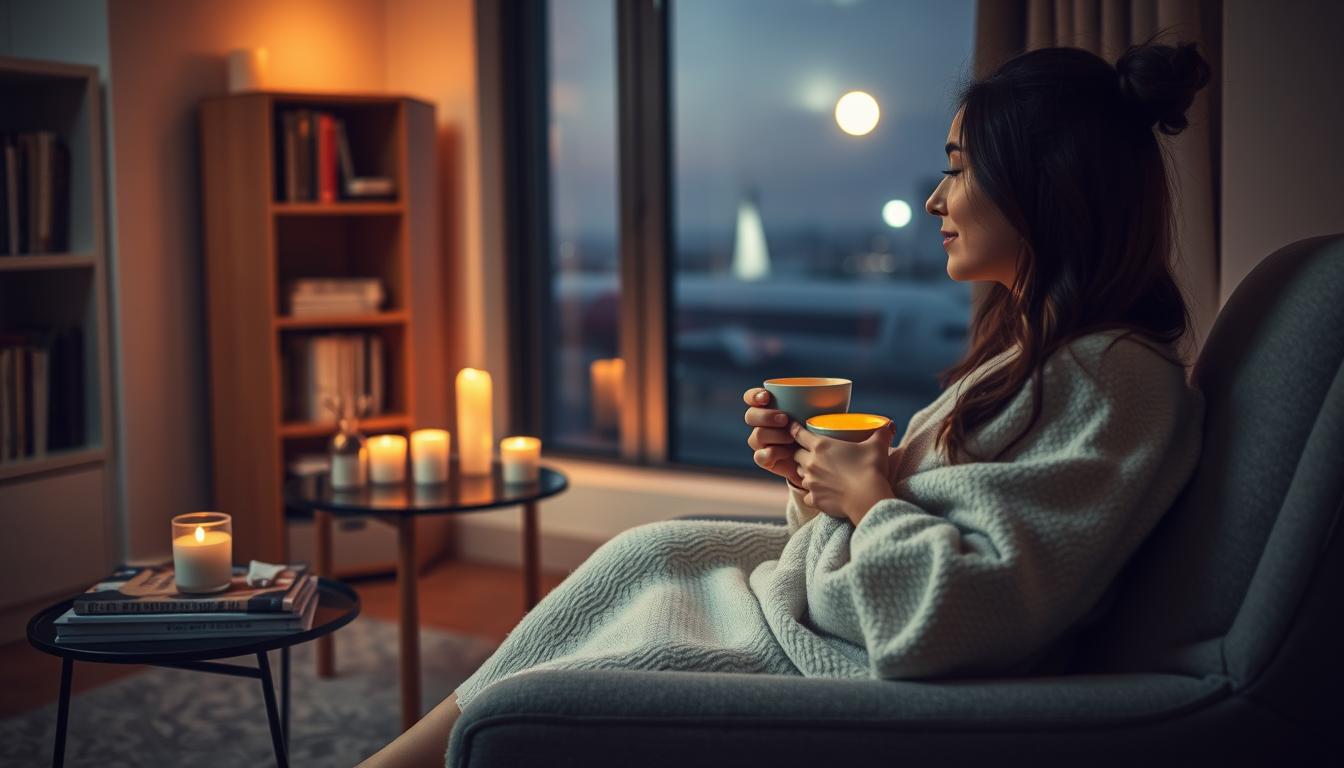
Revive After a Flight: Evening Recovery Routine
After a long flight, travelers often feel drained and disoriented due to travel fatigue. Implementing an effective evening recovery routine can significantly alleviate these symptoms, helping you feel refreshed and revitalized for the days ahead.
An evening routine tailored to address the effects of flying can make a substantial difference in how you feel upon arrival. This article will guide you through the essential steps to create a rejuvenating post-flight recovery plan.
Key Takeaways
- Simple techniques to reduce travel fatigue
- Essential steps for an effective evening routine
- Tips to enhance your post-flight recovery
- Strategies for a restful night’s sleep after flying
- Methods to rejuvenate your body and mind
The Physical Toll of Air Travel on Your Body
The physical toll of air travel is often underestimated, but its effects on the body are multifaceted. When we fly, our bodies are subjected to a range of stresses that can impact our circulation, muscles, and overall comfort.
How Flying Affects Your Circulation and Muscles
Flying can cause circulation to slow down, leading to swelling in the legs and feet. Prolonged sitting can also result in muscle stiffness, particularly in the legs and back. Improving circulation through simple exercises can help mitigate these effects.
The Impact of Cabin Pressure and Dry Air
Cabin pressure changes during flight can lead to discomfort, including ear pain and sinus pressure. Additionally, the dry air in cabins can dehydrate the Skin and respiratory system. Understanding these effects is crucial for taking preventive measures.
| Physical Effect | Cause | Relief Measure |
|---|---|---|
| Circulation Issues | Prolonged Sitting | Simple Leg Exercises |
| Muscle Stiffness | Lack of Movement | Stretching |
| Dry Skin | Dry Cabin Air | Hydration and Moisturizing |
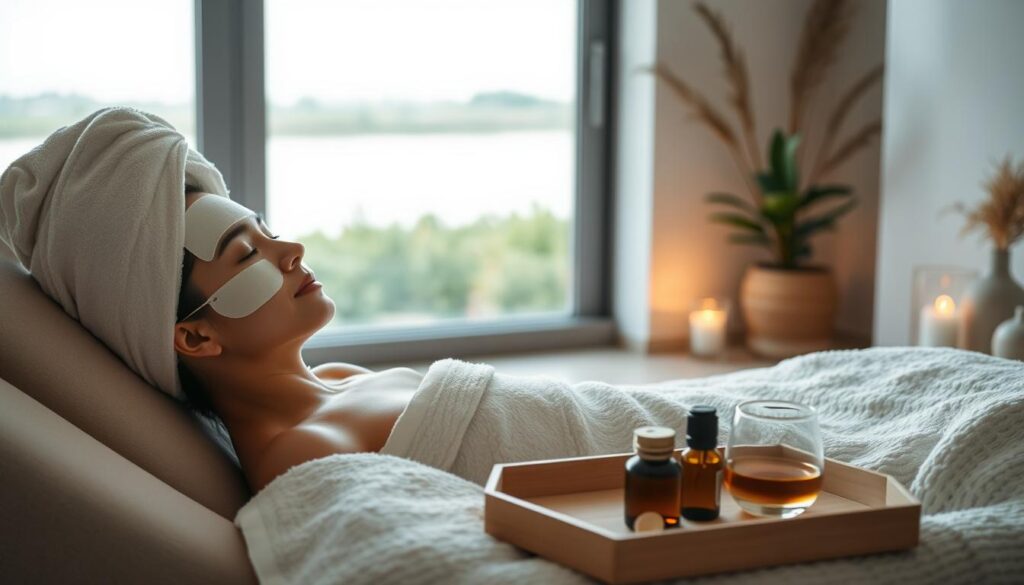
Understanding Jet Lag and Time Zone Transitions
Traveling across time zones can be a thrilling experience, but it often comes with the unwelcome companion of jet lag. Jet lag occurs when your body’s internal clock is disrupted due to traveling across different time zones, affecting your circadian rhythm.
How Your Circadian Rhythm Gets Disrupted
Your circadian rhythm is regulated by an intricate system that responds to light and darkness to synchronize your physiological processes with the 24-hour day-night cycle. When you travel across time zones, this rhythm is disrupted, leading to difficulties in sleeping, waking, and other bodily functions.
East vs. West Travel: Different Recovery Needs
Traveling east requires advancing your clock, which can be more challenging than traveling west, where you delay your sleep-wake cycle. This difference affects how quickly you adjust to the new time zone. Eastbound travel typically demands a more significant adjustment.
Calculating Your Body’s Adjustment Timeline
A general rule of thumb is that it takes about one day to adjust for each time zone crossed when traveling east, and slightly less when traveling west. Understanding this can help you plan your time zone adjustment more effectively.
| Time Zones Crossed | Eastbound Adjustment | Westbound Adjustment |
|---|---|---|
| 1-2 | 1-2 days | 1 day |
| 3-4 | 3-4 days | 2-3 days |
| 5+ | 5+ days | 4+ days |
As Dr. Charles Czeisler notes, “The human circadian clock can be reset to the local time zone, but it takes time.” Planning and understanding your body’s needs can make a significant difference in recovering from jet lag.
First Steps: What to Do Immediately After Reaching Your Accommodation
Reaching your destination is just the beginning; what you do next can make or break your post-flight recovery. As you enter your accommodation, your priority should be to create an environment that promotes relaxation and rejuvenation.
Unpacking Essentials vs. Full Unpacking
Start by unpacking essentials such as comfortable clothes, toiletries, and any medication you may need. “Unpacking is not just about organizing your belongings; it’s about creating a sense of home and comfort in a new environment,” says travel expert, Laura Jenkins. Avoid full unpacking immediately; instead, focus on making your space livable.
Setting Up Your Space for Recovery
Transform your accommodation into a recovery sanctuary. Adjust the lighting to a comfortable level, and consider using a white noise machine or a calming app to mask any background noise. Ensure the temperature is comfortable, promoting a restful environment.

Quick Shower Techniques to Refresh
A quick shower can be incredibly refreshing. Alternate between warm and cool water to invigorate your circulation. This technique, known as contrast showering, can help reduce muscle soreness and increase your energy levels.
By following these initial steps, you can significantly enhance your post-flight recovery, setting the stage for a restful stay and a productive or enjoyable trip ahead.
Hydration Strategies for Post-Flight Recovery
Proper hydration is key to helping your body recover from the stresses of flying. After a long flight, your body is dehydrated due to the dry cabin air, which can lead to fatigue, headaches, and other discomforts. Effective hydration strategies can mitigate these effects.

Rehydration Techniques Beyond Plain Water
While drinking plain water is a good start, there are other rehydration techniques to consider. Herbal teas, for example, can provide hydration along with additional health benefits. Herbal teas like peppermint or chamomile can soothe your digestive system and promote relaxation. You can also consider consuming hydrating foods like watermelon or cucumbers, which have high water content.
Electrolyte Replacement Options
Electrolytes are crucial for maintaining proper hydration levels, as they help regulate various bodily functions. During flights, electrolyte imbalances can occur due to dehydration. To replenish electrolytes, consider consuming coconut water or sports drinks that contain essential electrolytes like potassium and sodium. Another option is to consume electrolyte-rich foods or supplements.
Evening Recovery Routine Post-Flight: A Step-by-Step Guide
Implementing a post-flight recovery routine in the evening can be the key to rejuvenating your body and mind. After a long flight, your body needs care to recover from the stresses of travel.
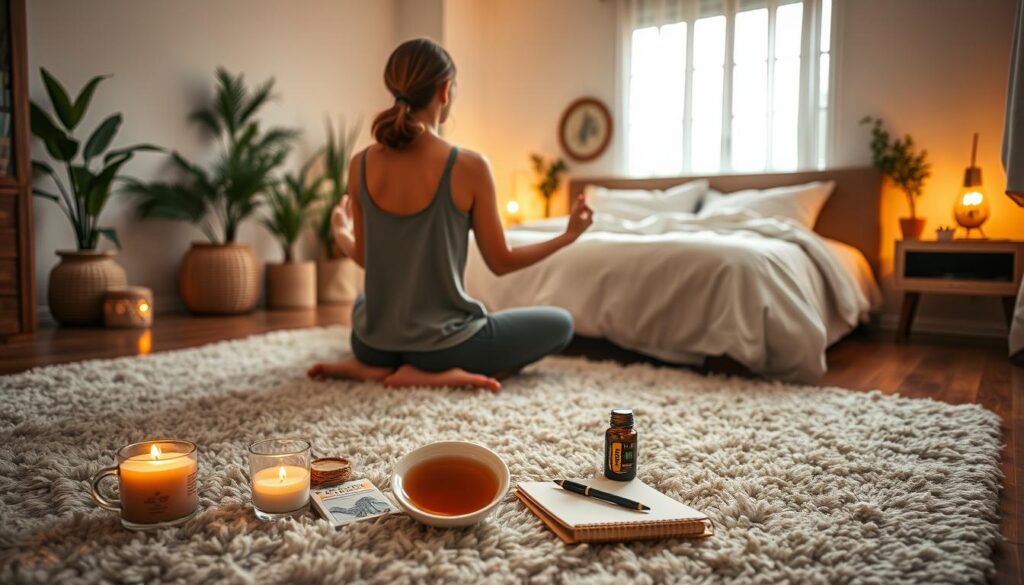
30-Minute Quick Recovery Plan
A quick recovery plan is ideal for those with limited time. Start with a warm shower to loosen up tight muscles. Follow this with some gentle stretching to improve circulation.
Next, rehydrate by drinking water or an electrolyte-rich beverage. Conclude with a few minutes of deep breathing exercises to calm your mind.
Extended 90-Minute Deep Recovery Process
For a more comprehensive recovery, consider a 90-minute routine. Begin with a relaxing bath or a calming tea to unwind.
Follow this with a massage or self-myofascial release to target areas of tension. Take time to meditate or practice mindfulness to reduce stress.
Finally, prepare your body for rest by cooling down and getting ready for bed. A consistent sleep schedule will help your body adjust to the new time zone.
Nourishing Your Body: Post-Flight Meal Recommendations
The right post-flight meal can help alleviate the physical discomforts associated with air travel. After a long flight, your body needs nutrients to recover from the stresses of flying, including dehydration and disrupted circadian rhythms.

Foods That Combat Inflammation and Bloating
Certain foods can help reduce inflammation and bloating caused by air travel. Omega-3 rich foods, such as salmon, and antioxidant-rich fruits like berries are excellent choices. Additionally, incorporating anti-inflammatory spices like turmeric into your meal can be beneficial.
Meal Timing Strategies for Different Arrival Times
The timing of your meal after a flight can significantly impact your recovery. If you arrive in the evening, a light meal that is easy to digest is recommended. For morning arrivals, a nutritious breakfast can help kickstart your day. Adjusting your meal times to the local schedule can also help your body adjust to the new time zone more quickly.
Restaurant Choices vs. Room Service
Deciding between dining out and room service depends on your energy levels and preferences. If you’re feeling refreshed, trying local cuisine at a nearby restaurant can be a great way to experience the culture. However, if you’re feeling fatigued, room service offers a convenient and comfortable alternative, allowing you to rest while still enjoying a satisfying meal.
Physical Recovery: Stretches and Light Exercises
The key to feeling refreshed after a flight lies in simple stretches and movements. After a long flight, your muscles can feel tight and your circulation may be sluggish. Engaging in some gentle stretches and light exercises can significantly aid in your physical recovery.
Targeted Stretches for Flight-Stressed Muscles
Certain stretches can help alleviate the discomfort caused by prolonged sitting during flights. Focus on stretching your calves, hamstrings, and lower back, as these areas tend to suffer the most. Simple calf raises, hamstring stretches against the seat in front of you, and gentle twists can make a big difference.
- Seated calf raise: Lift your heels off the floor, keeping your toes on the ground.
- Hamstring stretch: Slowly stand up and straighten your legs, then bend forward slightly.
- Lower back stretch: Gently twist your torso to one side and then the other.
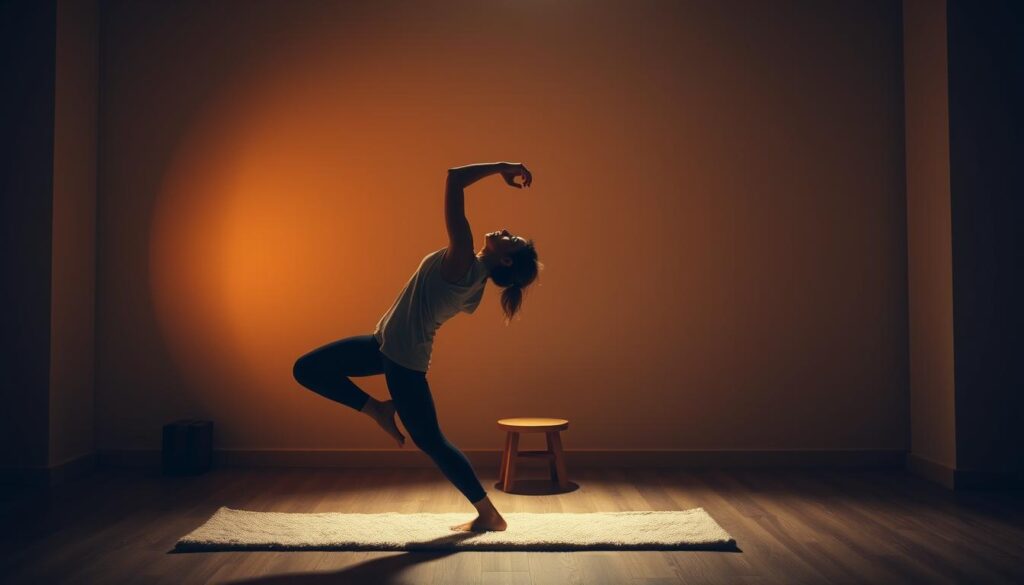
Gentle Movement to Restore Circulation
Gentle movements can help restore your circulation, reducing the risk of swelling and blood clots. Walking up and down the aisle during the flight or pacing in your hotel room can be very beneficial. Additionally, simple ankle rotations and toe wiggles can be done while seated.
| Movement | Benefit |
|---|---|
| Walking | Improves circulation, reduces swelling |
| Ankle rotations | Helps prevent blood clots, improves venous return |
| Toe wiggles | Stimulates foot circulation, reduces stiffness |
By incorporating these simple stretches and movements into your post-flight routine, you can significantly enhance your physical recovery, feeling more refreshed and ready to enjoy your trip or return to your daily activities.
Mental Reset: Relaxation Techniques After Travel
A mental refresh is just as important as physical recovery after flying. Travel stress can leave you feeling drained, both mentally and physically. Implementing relaxation techniques can help you unwind and adjust to your new environment more quickly.
Mindfulness Practices for Travel Stress
Mindfulness practices are effective in reducing travel-related stress. Techniques such as deep breathing exercises and meditation can calm your mind and help you focus on the present moment. You can find numerous guided mindfulness exercises online or through mobile apps like Headspace or Calm.
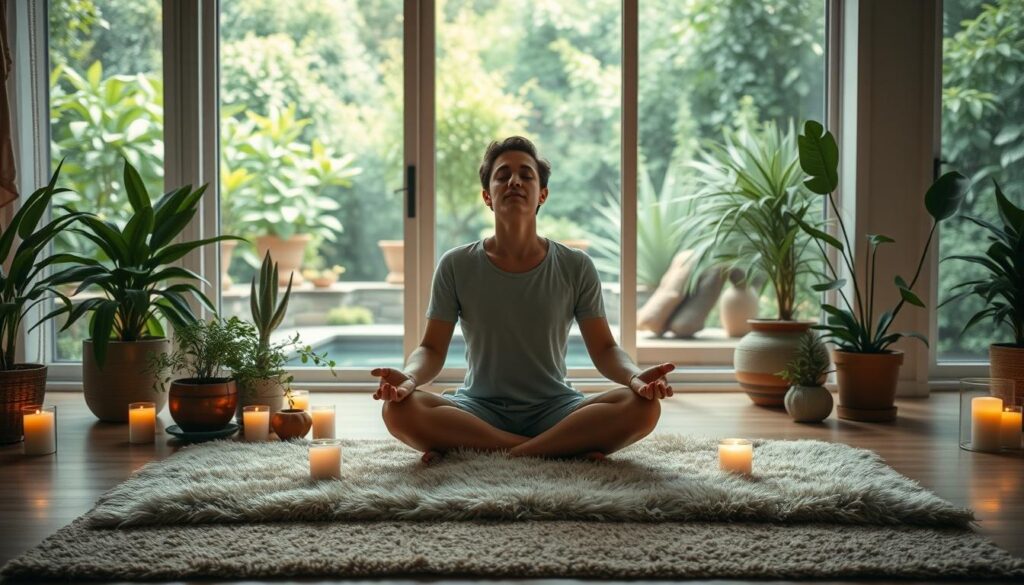
Digital Detox vs. Connecting with Loved Ones
After a long flight, you might be tempted to disconnect from the world with a digital detox. However, connecting with loved ones can also be incredibly uplifting. It’s not necessarily an either-or situation; you can choose to limit your social media use while still reaching out to family or friends. This balance can help you feel more grounded and supported in your new location.
Consider setting aside time for a relaxing activity, such as reading a book or taking a warm bath, to further enhance your mental recovery. By incorporating these relaxation techniques into your post-flight routine, you’ll be better equipped to handle the challenges of travel and enjoy your time away.
Optimizing Sleep After a Long Flight
Quality sleep is essential for mitigating the effects of jet lag and travel fatigue. After a long-haul flight, your body needs rest to recover from the physical and mental strain of travel.
Creating the Ideal Sleep Environment in a New Place
To optimize sleep, it’s crucial to create a conducive sleep environment. This involves ensuring the room is dark, quiet, and at a comfortable temperature. Use earplugs, eye masks, or blackout curtains if necessary. Additionally, invest in a comfortable mattress and pillows to enhance sleep quality.
Natural Sleep Aids for Post-Flight Rest
Consider using natural sleep aids to help you relax and fall asleep. Melatonin supplements are popular among travelers for adjusting to new time zones. Herbal teas like chamomile can also promote relaxation. A warm bath or shower before bed can help signal to your body that it’s time to sleep.
When to Use Sleep Medication
While natural aids are preferred, some travelers may need sleep medication for severe jet lag or travel stress. It’s essential to consult with a healthcare professional before using any sleep medication to discuss potential side effects and appropriate dosage.
Preparing for Your First Full Day: Morning Routine Planning
A well-structured morning routine is key to maximizing your day after a long-haul flight. Whether you’re traveling for business or leisure, a thoughtful morning routine can help you regain your energy and set a positive tone for the rest of your trip.
To make the most of your first full day, consider your travel goals and plan accordingly. For business travelers, this might mean focusing on productivity, while leisure travelers may want to ease into vacation mode.
Business Travelers: Maximizing Productivity After Travel
For business travelers, a productive morning routine is crucial. Start by setting clear goals for the day, and prioritize tasks that require focus and attention. Consider incorporating activities that boost energy and productivity, such as:
- A nutritious breakfast to refuel
- A short exercise routine to get the blood flowing
- A quick review of your schedule and tasks for the day
By incorporating these activities into your morning routine, you can maximize your productivity and make the most of your business trip.
Leisure Travelers: Easing Into Vacation Mode
For leisure travelers, the morning after a flight is an opportunity to ease into vacation mode. Consider starting the day with relaxing activities, such as:
- A leisurely breakfast in a local café
- A gentle stretch or yoga routine to loosen up tight muscles
- A short walk to explore your surroundings
By easing into your vacation, you can shake off the fatigue of travel and make the most of your leisure time.
By planning your morning routine according to your travel needs, you can set yourself up for a successful and enjoyable trip.
Conclusion: Making Recovery Part of Your Travel Routine
Incorporating a recovery routine into your travel habits can significantly enhance your overall travel experience. By understanding the physical and mental toll of air travel, you can take proactive steps to mitigate its effects.
Establishing a consistent recovery routine helps your body adjust to new environments and time zones, reducing the risk of fatigue and stress. This, in turn, allows you to make the most of your trip, whether you’re traveling for business or leisure.
By integrating the strategies outlined in this article into your travel routine, you can ensure a smoother transition into your destination and a more enjoyable experience overall. Prioritizing recovery is key to maintaining your physical and mental well-being while traveling.





